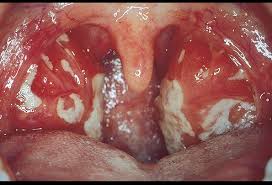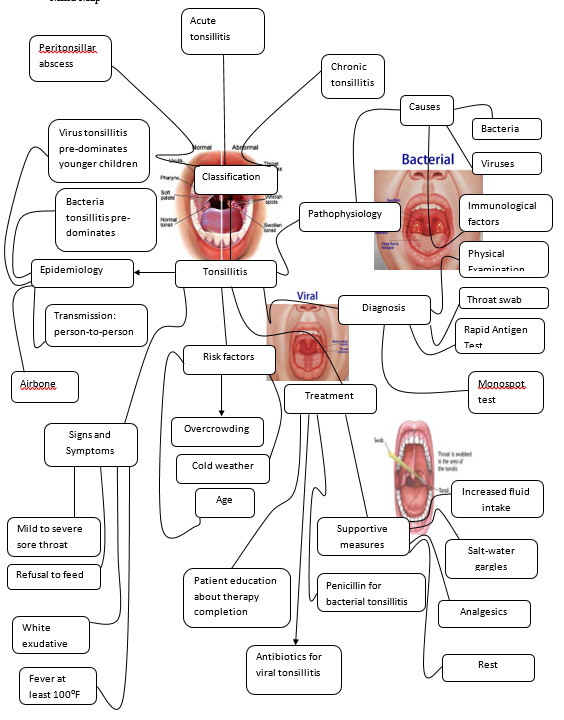Introduction
Acute tonsillitis is a type of tonsillitis that occurs within some few days. Other types of tonsillitis are chronic, recurrent, and peritonsillar abscess. Chronic tonsillitis is attributed to persistent acute infection, or recurrent infections, that prevail for more than one year. This paper aims at giving insight into the topic of acute tonsillitis.
Epidemiology
Tonsillitis mainly affects children between the ages 5 and 15 years. Both boys and girls fall victims to this disease. GABHS accounts for 12 to 35% of tonsillitis infections among children. Generally, tonsillitis is an infection from beta-hemolytic streptococci, but still, it can be attributed to bacteria or viruses. The viral tonsillitis is typically self-limiting in comparison to the bacterial infections (Kingsnorth & Bowley, 2011, p. 309).
Pathophysiology
Tonsillitis is “the inflammation and infection of tonsils and lymphatic tissues found on each side of the throat” (Ignatavicius & Workman, 2013, p. 644). Tonsils are almond-shaped lymphatic tissues covered with a mucous membrane. Small valleys called crypts occur across their surface. Faucial/palatine tonsils position themselves behind the fauces’ pillars while lingual tonsils are behind the tongue’s pillars. The tonsils are an important part of the immune system because they prevent the entry of organisms into the respiratory tract. Acute tonsillitis is less complicated, and it is an aftermath of upper respiratory infection.
According to the scenario, it is evident that the child’s nutritional status is still in check. The lack to feed is due to the irritation by the erythematous and exudating tonsils. This irritation is also making Jeniffer fussy because of her altered metabolic functions. She has fever, which is a common symptom to tonsillitis and high pulse and respiratory rates. This type of tonsillitis lasts 4 to 6 days and is common among children than adults.
Risk factors
Age
Tonsillitis is common in children less than ten years. According to the American Academy of Otolaryngology (2014), children between the ages 5 and 15 will suffer from tonsils attributed to streptococcus while younger children will suffer from tonsils resulting from viruses.
Poor ventilation
Acute tonsillitis is a contagious airborne disease. Therefore, crowdiness in a room that is poorly ventilated predisposes individuals at risk of the disease in case some of the individuals in the room have the disease.
Allergens
According to Batra (2011), allergens that include flavours and preservatives, peanuts, cold foods, sugary foods, sour food, and peanuts predispose susceptible individuals to tonsillitis.
Environment
Dampness, coldness and pollutants trigger the occurrence of tonsillitis.
Diagnosis
Group A beta-hemolytic streptococci (GABHS) cannot be diagnosed using a simple, rapid test. Despite the fact that tissue culture is difficult to obtain and is inconclusive, at times, this remains the ideal mode of diagnosing GABHS. Some authors will confuse acute tonsillitis with pharyngitis; that is why diagnosis is a critical step that should be conducted with all the scrutiny to help discern the two. In a bit to avoid confusion between acute tonsillitis and other similar upper respiratory infections, a rapid antigen test, Monospot test and throat culture and sensitivity are recommended (Ignatavicius & Workman, 2013).
Clinical Presentations
A patient with acute tonsillitis presents with “fever, lymphadenopathy, dysphagia, red or exudative tonsils and sore throat” (Elisha, 2011, 4). Sometimes a person snores, breathes using the mouth and experiences obstructive sleep apnea. The tonsils usually appear enlarged and erythematous. This enlargement obstructs the pharyngeal opening of the Eustachian tube resulting in otitis media. The latter condition is attributed to obstruction of the pharyngeal opening, thereby preventing the Eustachian tube from ventilating and draining the middle ear. In the case of Jeniffer, the white exudates (shown in the figure below) and enlarged tender cervical lymph glands indicate that the infection is due to bacteria (Addison, Brown, Edwards & Gray, 2012).

Alterations
Dysphagia is a common challenge for patients with tonsillitis, but they can adapt to these alteration by consuming a lot of fluids, especially in the case of prevailing fever. Dysphagia is attributed to enlargement of the tonsils, but it is important to distinguish between normal tonsil enlargement and enlargement due to infection. In addition, complications of acute tonsillitis occur when abscess develops. These complications results from partly treating the acute tonsillitis. Prior to dysphagia, patients have a sore throat that makes it difficult for them to swallow anything as is the case with Jeniffer; she has refused to feed. When tonsils caused by GABHS are not completely eradicated, the sequelae are rheumatic fever or cute glomerulonephritis (Ignatavicius & Workman, 2013, p. 645). Therefore, patient education is critical to helping parents understand the essence of helping their children complete the treatment.
Mind Map

Conclusion
Tonsillitis is an infection of the upper respiratory tract that interferes with normal food intake. It can be attributed to either bacteria or viruses. The first line for bacterial tonsillar infection is penicillin, but other medications such as cephalosporins are equally useful as alternatives. Antibiotics are ideal for viral tonsillar infection. Preventive measures are imperative for the prevention of this disease, such as proper ventilation and humidified air.
References
Addison, B., Brown, A., Edwards, R., & Gray, G. (2012). Minor illnesses or major disease? (5th ed.). Pharmaceutical Press.
American Academy of Otolaryngology-Head and Neck Surgery. (2014). Tonsillitis. Web.
Batra, M. (2011). Healing with Homeopathy. Mumbai: Jaico.
Elisha, S. (2011). Case Studies in Nurse Anesthesia. Sudbury: Jones and Bartlett.
Ignatavicius, D., & Workman, M. (2013). Medical Surgical Nursing (7th ed.). Missouri: Elsevier Saunder.
Kingsnorth, A., & Bowley, D. (Eds). (2011). Fundamentals of Surgical Practice: A Preparation Guide for the Intercollegiate MRCS Examination (3rd ed.). New York: Cambridge University Press.